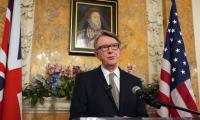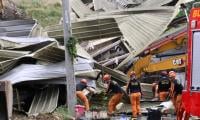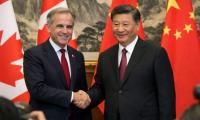Fixing the taxation system - Part II
Studies on sectoral incidence show that industry bears more than two-thirds of the tax, while the services sector bears about 21 per cent and agriculture 3.0 per cent.
In the services sector, transportation and trade together account for one-third of GDP. The wholesale and retail trade sector contributes 18 per cent to GDP but pays only 2.9 per cent in income tax. The potential realizable gap in this sector is 0.5 per cent of GDP. Except for a few companies, the transport subsector is dominated by small- and medium-size operators. Only air and shipping companies yield some revenues. Similarly, out of 2.7 million wholesale and retail trade units (employing a population of nine million), 85 per cent are small family-run stores.
The entire direct and sales tax collection from the trade sub-sector constitutes 0.5 per cent of federal taxes. Real-estate services contribution to GDP is vastly understated due to huge undervaluation of the stated transactions. It is well known that this sector is the main source fueling the informal economy as most of the settlements take place in cash.
As two-thirds of the tax collected in the last decade is in the form of indirect taxes and one-fourth of the entire amount comes from petroleum and petroleum products at various stages (which is passed on to consumers) the overall incidence is regressive. Even where direct taxes are concerned, two-thirds consist of withholding taxes which are deemed to be the full and final settlement of tax liability. So, in terms of the impact on different income groups the burden falls disproportionately on the poor and middle-income groups.
On top of this, policymakers, in their attempt to attain revenue targets, impose additional levies on existing taxpayers. This disincentive leads to the quest for various loopholes in the complex tax code — saddled with enormous discretionary regulations — to understate incomes, claim exemptions and avoid paying full taxes in collusion with tax officials.
Direct evidence and hard facts regarding the informal and illicit economy are difficult to gather. Casual empiricism points to a gradual expansion in the informal sector’s share through workers’ remittances, understated property income, proliferation of unregistered enterprises such as boutiques, tuition centers, schools, clinics, beauty salons, restaurants etc.
In the rural areas, the informal sector includes intermediaries in mandi towns and agriculture produce market and other input and services providers. Their common feature is that they are all outside the tax net. One of the indicators of the informal economy or cash driven undocumented economy is the currency in circulation that has jumped from 11 per cent to 20 per cent of GDP in just a decade.
In the last decade, illicit incomes earned through corruption and bribery by public office-holders, extortion, robberies, ransom, extractions by land, water and other mafias, prostitution, gambling dens and other illegal and criminal activities have multiplied manifold. Therefore, the taxable base even in urban areas is shrinking because of the transfer of incomes from the formal to the informal/illicit economy.
As a consequence of the enlarged scope of the informal and illicit economy, less than 1.1 per cent of GDP is collected as actual direct income tax. The top 20 per cent of the population or six million households receive 50 per cent of the national income. The potential taxpayer base for individual income tax is 6.4 million if we accept registration under national tax numbers at its face value. The number of those who qualify for the minimum threshold of taxable income — if properly assessed, audited, enforced and exemptions and concessions withdrawn — could stretch to some four million.
At the moment, out of the 6.4 million registered with the national tax number, only 2.7 million individuals and firms file tax returns. Leaving aside the salaried class, many of the filers do not fully disclose their income and half of the returns show nil income while 3.7 million do not file any returns. Some 272,000 firms are registered in the sales tax system but only 168,000 actually file any tax returns, most of them showing nil taxable income. The latest data available shows that only 21 per cent of registered companies paid any income tax while 80 per cent of the total amount was collected from the multinationals and a few large Pakistani companies. As much as 82 per cent of the total sales tax and federal excise duty is collected from only 100 companies.
In the formal sector, the documented coexist with the undocumented firms. As the former are evading payment of sales tax either by remaining below the threshold level or misrepresenting their true turnover, they are able to sell at lower prices than the documented firms, the aggregate sales of the documented firms decline and consequently tax collection is lowered.
It is apparent that in this environment the traditional tools of rate changes, assessment, compliance, audit etc will remain blunt unless the share of income in the formal sector rises, and exemptions, concessions and waivers within this sector are eliminated and new assesses are added.
One of the worrisome trends that has become highly inimical to private business development and investment in Pakistan is the rising burden of taxation on those who are already in the tax net. Corporates are paying as much as 40-50 per cent of their profits in the form of various taxes, super tax, cesses, fees, EOBI, social security, Workers Welfare Fund , dividends etc. While these corporates are expected to invest their earnings in expansion or new ventures, the tax regime requires them to distribute at least 40 per cent of their profits in the form of dividends.
Pakistan is stuck with low investment-to-GDP ratio of 15-16 per cent while in India it exceeds 30 and Bangladesh around 30 per cent. Capital formation will not take place if tax penalizes effort and entrepreneurship and acts as a disincentive to future expansion. The government is also in a bind as the tax-to-GDP ratio hovers around 10-12 per cent and is inadequate to meet the demands of development, debt servicing and defence. It therefore opts for an easy way out — levy additional tax burden on the existing taxpayers, which is by no means a wise thing to do. Going for those outside the tax net, evading or understating taxes or underreporting income requires strong audit and enforcement capacity which is lacking. Performance evaluation is based on a single indicator — the achievement of the given tax target and hence provides no incentive for broad basing the tax net.
Most of the discussion and discourse on public finances has remained focused on the federal government and FBR. The analysis of provincial finances has been sketchy and shallow, although it should occupy a salient place in the aftermath of the 18th Amendment and 7th National Finance Commission Award. Very little attention has been paid to realize the potential of provincial taxes. Provinces now receive almost 60 per cent of the share from the divisible tax pool and they are quite content with mobilizing only one per cent of GDP in the form of provincial revenues.
The World Bank has estimated that the potential of own taxes in Punjab alone is at least four times the present level of tax collection. Our calculations show that at least 1.6 per cent of GDP can be additionally generated through sales tax, property tax, agriculture income tax and irrigation water charges. (For details please refer to ‘Repairing provincial finances, The News, August 12, 2022)
As tax revenues are not adequate to meet its needs, the government has to borrow internally from the banking system and externally from international financial institutions to fill the gap between its revenues and expenditures. High indebtedness leads to rising cost of debt servicing that now takes away 60 per cent of tax revenues. Another 25 per cent goes towards defence and spending 20 per cent for subsidies, leaving very little for development expenditure. Thus mobilizing tax revenues is the top priority for the country’s economic managers.
To be continued
The writer is the author of 'Governing the ungovernable'.
-
 Google Ends Dark Web Personal Data Leak Alerts From January 15
Google Ends Dark Web Personal Data Leak Alerts From January 15 -
 Elon Musk’s X In Legal Trouble: List Of Countries Taking Action Over Grok AI Deepfakes
Elon Musk’s X In Legal Trouble: List Of Countries Taking Action Over Grok AI Deepfakes -
 Prince William Takes Shocking New Stance On Prince Harry's Fight For Security
Prince William Takes Shocking New Stance On Prince Harry's Fight For Security -
 Kate Middleton Sends Powerful Message To Meghan Markle, Prince Harry
Kate Middleton Sends Powerful Message To Meghan Markle, Prince Harry -
 BBC Seeks Dismissal Of Trump's $10bn Defamation Lawsuit
BBC Seeks Dismissal Of Trump's $10bn Defamation Lawsuit -
 Ex-UK Envoy Mandelson Issues ‘unequivocal’ Apology To Epstein's Victims
Ex-UK Envoy Mandelson Issues ‘unequivocal’ Apology To Epstein's Victims -
 Kate Middleton Accused Of Being ‘silent Assassin’ Pitting William Against Andrew
Kate Middleton Accused Of Being ‘silent Assassin’ Pitting William Against Andrew -
 Meghan Markle, Harry 'deliberately' Snubbed Kate Middleton Ahead Of UK Return
Meghan Markle, Harry 'deliberately' Snubbed Kate Middleton Ahead Of UK Return -
 Elon Musk Seeks Sole Custody Of Son After Ashley St. Clair's Trans Support
Elon Musk Seeks Sole Custody Of Son After Ashley St. Clair's Trans Support -
 How To Spot Real Instagram Password Reset Email
How To Spot Real Instagram Password Reset Email -
 Kylie Jenner Makes Subtle Appearance On Timothee Chalamet's Social Handle
Kylie Jenner Makes Subtle Appearance On Timothee Chalamet's Social Handle -
 Jennifer Lawrence Shares Rare Insight Into Relationship With Hubby Cooke Maroney
Jennifer Lawrence Shares Rare Insight Into Relationship With Hubby Cooke Maroney -
 Philippines: Rubbish Landfill Collapse Death Toll Rises To 13
Philippines: Rubbish Landfill Collapse Death Toll Rises To 13 -
 Kate Middleton Fears For Family After Shocking Palace Break-in
Kate Middleton Fears For Family After Shocking Palace Break-in -
 Sanae Takaichi, Lee Jae Myung Meet To Push For Closer Security And Economic Ties At High-stakes Summit
Sanae Takaichi, Lee Jae Myung Meet To Push For Closer Security And Economic Ties At High-stakes Summit -
 Canadian PM Visits China After A Decade Of Diplomatic Strain: What Deals Are In Focus?
Canadian PM Visits China After A Decade Of Diplomatic Strain: What Deals Are In Focus?



